October 28, 2023
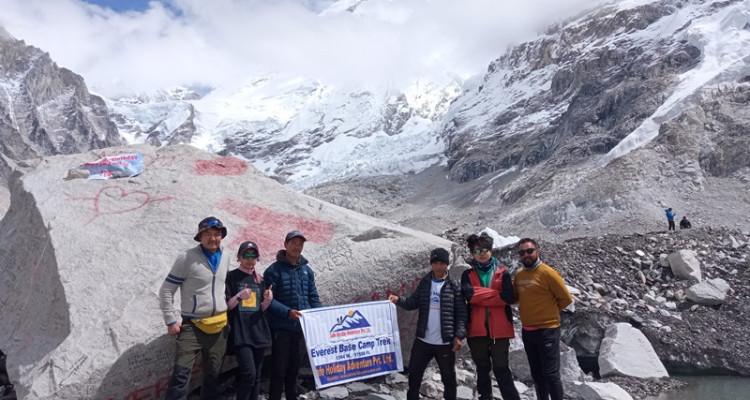
The Everest Base Camp trek is a renowned and iconic trekking adventure that allows hikers to explore the breathtaking landscapes of the Khumbu region in Nepal, as well as experience the rich culture of the local Sherpa communities. This challenging yet rewarding journey takes you to the foot of the world’s highest peak, Mount Everest, standing at a towering height of 8,848 meters (29,029 feet). The trek offers a unique opportunity to witness the beauty of the Himalayas, visit traditional Sherpa villages, and immerse yourself in the majesty of the Everest region.
To make the most of your Everest Base Camp trek, it’s essential to have a well-structured itinerary that takes into account acclimatization, physical challenges, and the best times to experience the stunning scenery. Here’s a sample 15-day itinerary:
Day 1: Kathmandu to Lukla (2,800 meters/9,186 feet) to Phakding (2,652 meters/8,700 feet)

Lukla Airport-2,860m
Your Everest Base Camp adventure begins in Kathmandu, where you’ll take a thrilling flight to Lukla, a small mountain airstrip perched on the edge of a cliff. The scenic flight offers an initial taste of the spectacular Himalayan landscape. Upon landing in Lukla, you’ll start your trek by descending towards Phakding. The trail is relatively gentle, passing through picturesque Sherpa villages, prayer wheels, and fluttering prayer flags. Along the way, you’ll cross several suspension bridges over the Dudh Koshi River, connecting the steep valley sides. Phakding is your first overnight stop, where you can rest and prepare for the days ahead.
Day 2: Phakding to Namche Bazaar (3,440 meters/11,286 feet)

Way to Namche Bazaar from Phakding
The trek from Phakding to Namche Bazaar is a captivating journey through the heart of the Khumbu region in Nepal, a path often taken by trekkers on their way to the legendary Mount Everest Base Camp. The trail meanders alongside the rushing Dudh Koshi River, its turquoise waters glistening in the sunlight, as you gradually gain altitude. You’ll find yourself surrounded by lush, verdant forests of rhododendron and pine trees, creating a serene, picturesque atmosphere. The forest is alive with the melodious chirping of birds and the rustling of leaves, making it a peaceful escape from the hustle and bustle of daily life. The trek usually takes around 6 to 7 hours, covering approximately 9 kilometers (5.6 miles), and provides a moderate challenge due to the undulating terrain. However, the breathtaking views, charming teahouses, and warm hospitality of the local Sherpa people make it a rewarding and unforgettable journey. As you continue along this trail, the anticipation of reaching Namche Bazaar, a bustling Sherpa market town, builds, and the promise of even more stunning vistas and cultural experiences awaits.
Day 3: Acclimatization Day in Namche Bazaar

Acclimatization day at Namche- Short hike to Everest View Hotel
An acclimatization day in Namche Bazaar is a crucial pause in your trekking journey through the Everest region. Situated at an altitude of around 3,440 meters (11,286 feet), Namche Bazaar is a pivotal point for adjusting to higher elevations. During this day, trekkers have several options for how to spend their time.
Firstly, many choose to explore the area on foot. A popular activity is the hike to the Everest View Hotel, which offers awe-inspiring panoramic vistas of Mount Everest and other Himalayan peaks. Exploring local villages, visiting monasteries, or simply wandering through the bustling streets of Namche to experience the vibrant Sherpa culture are also enjoyable options.
Secondly, rest and relaxation are vital during acclimatization. Taking it easy, sipping on warm tea, reading a book, or immersing yourself in the mountain ambiance are all ways to rejuvenate.
Ensuring that you stay well-hydrated and maintain a balanced diet is another key aspect of the day. Proper nutrition and hydration are essential for your body to cope with the altitude and the upcoming challenges of your trek.
In some teahouses, you might have the opportunity to attend informative sessions on altitude sickness and acclimatization, which can provide valuable insights into the potential risks and how to mitigate them.
Lastly, Namche Bazaar’s bustling market is an excellent place to shop for trekking gear, souvenirs, and local crafts, making it a popular activity during your free time.
Taking an acclimatization day in Namche Bazaar is not just a break but a strategic move to reduce the risk of altitude-related health issues. It prepares you for the challenges ahead as you continue your trek to higher elevations, including destinations like Tengboche, Dingboche, and eventually Everest Base Camp. It’s a day to both relax and equip yourself for the adventures and breathtaking experiences that await in the Everest region.
Day 4: Namche Bazaar to Tengboche (3,860 meters/12,664 feet)
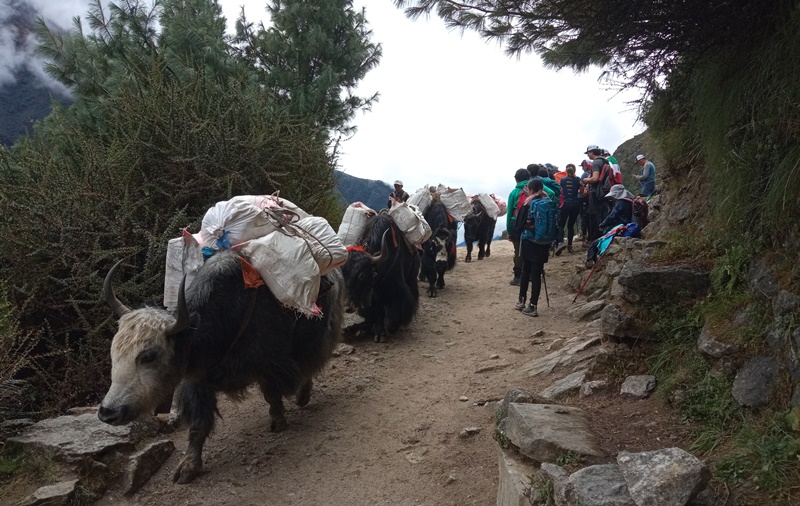
Yaks carrying trekkers luggage to Tengboche
The trek from Namche Bazaar to Tengboche in the Khumbu region of Nepal is a captivating journey through the heart of the Himalayas. It is a segment of the popular trek to Everest Base Camp and offers trekkers a chance to immerse themselves in the breathtaking landscapes and unique culture of the region.
Starting from Namche Bazaar, a bustling Sherpa town situated at an altitude of 3,440 meters, the adventure begins. Namche serves as a vital acclimatization point, allowing trekkers to adjust to the increasing altitude before heading further into the mountains. The town is nestled in a natural amphitheater surrounded by towering peaks and provides a glimpse into the Sherpa way of life with its bustling markets and teahouses.
As you depart Namche Bazaar, the trail initially descends through a lush forest adorned with rhododendron and juniper trees. The descent leads to the picturesque village of Sanasa at an altitude of 3,600 meters. The path is filled with sights and sounds of nature, and the crisp mountain air invigorates the senses.
After Sanasa, the journey continues to Phunki Tenga, a charming settlement at an elevation of 3,250 meters. Here, the trekking path meets the convergence of two vital rivers, the Dudh Koshi and Imja Khola. To reach Phunki Tenga, you’ll cross a suspension bridge, an iconic feature of this region’s landscape. The village provides a serene stopover point, offering a taste of local hospitality and a moment to appreciate the beauty of the surrounding rivers and forests.
The final leg of the journey leads to Tengboche, perched at an altitude of 3,860 meters. Tengboche is renowned for its namesake monastery, the Tengboche Monastery, which is one of the most significant monastic institutions in the Khumbu region. The spiritual ambiance and the stunning panoramic views from Tengboche make it a highlight of the trek. Ama Dablam, Everest, and other majestic peaks can be admired from this vantage point, creating a sense of awe and reverence.
Throughout the trek, you’ll experience a dynamic mix of terrains, including both ascents and descents, while navigating dense forests and crossing suspension bridges. The trek requires careful acclimatization and preparedness for ever-changing weather conditions. Altitude and mountainous terrain present their challenges, and trekkers are advised to take their time, stay hydrated, and heed the guidance of experienced local guides.
The route from Namche Bazaar to Tengboche encapsulates the essence of the Himalayas, offering not only the allure of majestic mountains but also the cultural richness of the Sherpa people. It’s a journey that promises unforgettable moments in one of the most remarkable landscapes on Earth.
Day 5: Tengboche to Dingboche (4,410 meters/14,468 feet)
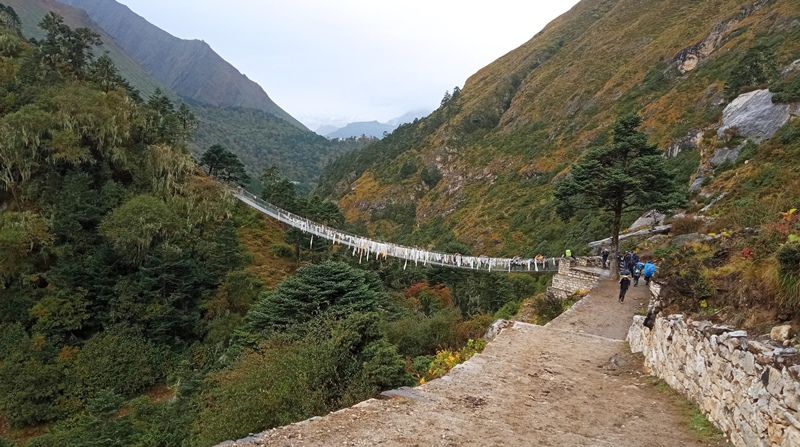
High Suspension Bridge while trekking from Tengboche to Dingboche
The trek from Tengboche to Dingboche is an enchanting and challenging journey that takes you deeper into the Khumbu region of Nepal. This segment of the Everest Base Camp trek offers trekkers a chance to experience the unique beauty of the Himalayan landscape, from lush forests to more arid terrain as you ascend to higher altitudes.
Starting from Tengboche, a spiritual and cultural center in the Khumbu region, the trail initially descends towards the small village of Debuche. The descent involves crossing a suspension bridge over the Imja Khola river. After crossing the river, you begin the ascent on the opposite side, gradually gaining altitude once again. Debuche is a serene village with tea houses and lodges, making it an ideal spot to take a break and refuel.
Continuing on your journey, the trail meanders through dense forests adorned with rhododendron and juniper trees. As you ascend, you’ll reach the village of Pangboche, another picturesque Sherpa settlement. Pangboche is known for its beautiful gompa (monastery), and it provides trekkers with an opportunity to explore the local culture and enjoy breathtaking mountain vistas.
Leaving Pangboche, the landscape gradually becomes more arid, and you’ll find yourself trekking through higher-altitude terrain. Somare is the next village you’ll come across on the trail, offering spectacular views of iconic peaks like Ama Dablam. The elevation at this point is around 4,000 meters, which requires careful acclimatization and pacing.
Further along the trail, you’ll encounter the villages of Orsho and Shomare. These settlements, at approximately 4,110 meters and 4,010 meters, respectively, are relatively small and provide essential teahouses where trekkers can rest, eat, and replenish their energy.
Dingboche, your ultimate destination, lies at an altitude of around 4,410 meters. It’s a significant acclimatization point on the Everest Base Camp trek. Dingboche is a picturesque village with fields of barley and potatoes surrounded by stone walls to protect crops from the harsh mountain winds. From Dingboche, you’ll have stunning views of Lhotse, Island Peak, and other towering peaks. It’s essential to take your time acclimatizing in Dingboche before continuing your trek to even higher elevations toward Everest Base Camp.
The journey from Tengboche to Dingboche combines natural beauty, cultural richness, and the thrill of ascending to higher altitudes in the Himalayas. It’s a segment of the trek that offers trekkers a chance to immerse themselves in the wonders of the region while taking the necessary precautions to ensure a safe and enjoyable adventure.
Day 6: Acclimatization Day in Dingboche
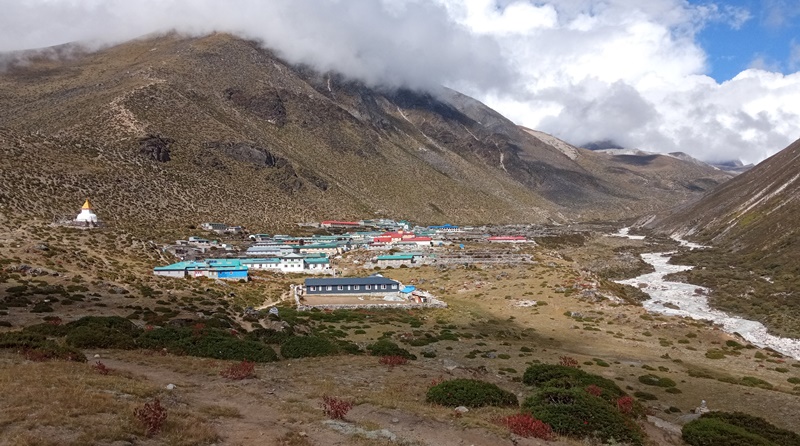
Beautiful Dingboche Village -EBC trek
Dingboche, a picturesque village nestled in the heart of the Khumbu region of Nepal, is an essential acclimatization stop for trekkers and climbers on their journey to Everest Base Camp. Perched at an altitude of approximately 4,410 meters (14,468 feet), Dingboche offers a stunning backdrop of towering Himalayan peaks, including Ama Dablam and Lhotse. This idyllic settlement serves as a crucial acclimatization point, allowing adventurers to adjust to the thinning air and avoid altitude-related ailments. During your stay in Dingboche, you can embark on a short but rewarding hike to Nangarkhan Hill. This hill, situated on the outskirts of the village, offers a breathtaking panoramic view of the surrounding mountains and valleys. The hike to Nangarkhan Hill not only aids in acclimatization but also provides a serene escape into the Himalayan wilderness. As you traverse the rocky paths and breathe in the crisp mountain air, you’ll find yourself immersed in the natural beauty and tranquility of this high-altitude haven. Dingboche is not only a place to acclimatize but a destination that encapsulates the serene grandeur of the Himalayas, making it an integral part of any trekking or mountaineering expedition in the Everest region.
Day 7: Dingboche to Lobuche (4,940 meters/16,207 feet)
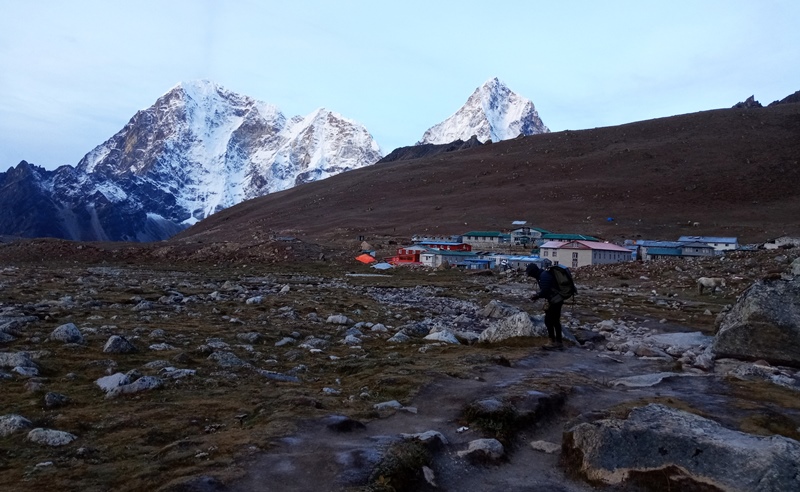
2nd Last place of Everest Base camp trek- Labuche
The trail from Dingboche to Lobuche in the Everest region of Nepal is a challenging yet awe-inspiring journey that takes trekkers through the heart of the Himalayas. As you leave Dingboche, you embark on a gradual ascent through a high-altitude desert landscape, characterized by scattered shrubs and a barren, rocky terrain. The trail offers spectacular vistas of the surrounding peaks, with Ama Dablam and Lhotse dominating the horizon.
As you continue your trek, you’ll reach the village of Dughla, also known as Thukla, which serves as a common stopover point for trekkers. Here, you’ll find several memorials dedicated to climbers and mountaineers who lost their lives in the Everest region. The most prominent of these memorials is the Scott Fischer Memorial, dedicated to one of the climbers who perished in the tragic 1996 Everest disaster. The memorials serve as a poignant reminder of the risks and challenges that come with high-altitude mountaineering.
Leaving Dughla, the trail becomes steeper and more challenging as you ascend towards Lobuche. You’ll pass through a section of the trail known as the “Dughla Pass,” which features a collection of small stone memorials honoring climbers who lost their lives on Everest and other nearby peaks. These memorials stand as a testament to the indomitable spirit of adventure and exploration that draws people to this region.
The final stretch of the trail takes you to the village of Lobuche, which is situated at an altitude of around 4,940 meters (16,207 feet). This remote and rustic village is often used as a stopover point before trekkers continue their journey to Everest Base Camp. The journey from Dingboche to Lobuche, with its memorials and stark mountainous landscapes, is a physically demanding yet spiritually enriching experience, providing trekkers with a deep connection to the history and majesty of the Everest region.
Day 8: Lobuche to Gorak Shep (5,164 meters/16,942 feet) to Everest Base Camp (5,364 meters/17,598 feet) and back to Gorak Shep

Everest Base Camp-5,364m
The trek from Lobuche to Gorak Shep and on to Everest Base Camp is one of the most exhilarating and iconic segments of the Everest Base Camp trek. Here’s a description of the journey:
Lobuche to Gorak Shep (5,164 meters/16,942 feet): The trail from Lobuche to Gorak Shep takes you through a desolate, high-altitude terrain, characterized by rocky paths and scattered boulders. As you ascend, you’ll have awe-inspiring views of the Khumbu Glacier and the surrounding peaks. Gorak Shep, a small settlement located at an altitude of 5,164 meters, serves as the last outpost before reaching Everest Base Camp. The trek to Gorak Shep is challenging due to the high altitude and thin air, and it can take several hours. Upon reaching Gorak Shep, you’ll have a brief rest and prepare for the final leg of your journey.
Gorak Shep to Everest Base Camp (5,364 meters/17,598 feet): The trail from Gorak Shep to Everest Base Camp is both thrilling and demanding. It’s a relatively flat walk, but the high altitude can make it quite strenuous. The landscape is stark and rugged, with the Khumbu Icefall and the formidable walls of Everest looming in the distance. As you approach Everest Base Camp, you’ll be surrounded by the iconic sights of colorful prayer flags, expedition tents, and the ice-covered surface of the Khumbu Glacier. The sense of achievement as you step into Everest Base Camp, at an elevation of 5,364 meters, is unparalleled. It’s a place where dreams and reality converge, and trekkers often take time to reflect on the history and significance of this location.
Everest Base Camp back to Gorak Shep: After spending some time at Everest Base Camp, taking in the incredible surroundings and perhaps chatting with climbers and expedition teams, you’ll begin your journey back to Gorak Shep. The return hike, while mostly downhill, can still be physically demanding due to the high altitude. You’ll retrace your steps along the Khumbu Glacier, with the mighty Everest as your constant companion. Once you arrive back in Gorak Shep, you can rest, reflect on your remarkable accomplishment, and enjoy the breathtaking views of the sunset over the Everest massif.
This trek is a once-in-a-lifetime experience, allowing you to be in the heart of the world’s tallest mountains and to witness the incredible beauty and challenges of the Everest region. It’s a journey that embodies the spirit of adventure and exploration in the Himalayas.
Day 9: Gorak Shep to Kala Patthar (5,545 meters/18,192 feet) to Pheriche (4,280 meters/14,042 feet)

Way to Pheriche from Gorakshep
The journey from Gorak Shep to Kala Patthar to Pheriche is a challenging and breathtaking trekking experience in the Khumbu region of Nepal. Gorak Shep, situated at an elevation of 5,164 meters (16,942 feet), serves as a common base camp for trekkers and climbers attempting to reach the Everest Base Camp. The path from Gorak Shep to Kala Patthar is a significant highlight of the trek. Kala Patthar, standing at a lofty 5,545 meters (18,192 feet), is renowned for offering one of the most iconic and panoramic views of Mount Everest, as well as the surrounding Himalayan peaks. The hike to Kala Patthar is a strenuous uphill climb, and the high altitude makes it even more challenging. Trekkers often start their ascent in the pre-dawn darkness to witness the sunrise over Everest, casting a warm golden glow on the world’s tallest mountain.
Kala Patthar provides an unparalleled vantage point to see the majestic Everest and several other towering peaks in the region, including Lhotse, Nuptse, and Pumori. The stunning beauty of the mountains against the backdrop of the sunrise is a memory that trekkers cherish for a lifetime. After enjoying the awe-inspiring scenery at Kala Patthar, trekkers typically descend back to Gorak Shep for a well-deserved breakfast.
The journey continues as you make your way from Gorak Shep to Pheriche, which is situated at a lower altitude of 4,280 meters (14,042 feet). The descent from Gorak Shep to Pheriche involves walking through the rugged terrain of the Khumbu region. As you descend, the landscape gradually changes, and you’ll notice the vegetation becoming more lush and varied, with rhododendron forests and picturesque meadows dotting the trail. Pheriche is a charming and peaceful village that serves as a popular stopover for trekkers on their way to and from Everest Base Camp. It’s a place where trekkers can rest and acclimatize to the lower altitude before continuing their journey.
The transition from the lofty heights of Kala Patthar to the lower altitude of Pheriche offers a stark contrast in scenery, from barren, snow-capped peaks to a more hospitable environment with a warmer climate. Pheriche provides a glimpse into the local Sherpa culture, with its monasteries, prayer flags, and hospitable teahouses, where trekkers can savor hearty meals and engage with the local community. Overall, this trek from Gorak Shep to Kala Patthar to Pheriche is an adventure that combines challenging ascents, breathtaking views, and a cultural experience, making it a memorable and enriching part of the Everest Base Camp trek.
Day 10: Pheriche to Namche Bazaar
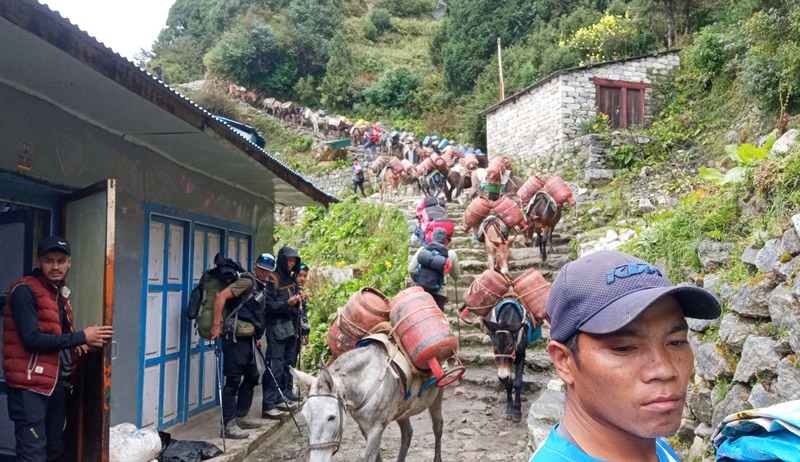
Donkeys’ are carrying goods – suppling to Namche Bazaar
Starting the morning in Pheriche, a serene village perched at around 4,371 meters, you awaken to the crisp mountain air and panoramic views of the Himalayan peaks. After a hearty breakfast, you set out on the retraced journey to Namche Bazaar, initially descending through a landscape that alternates between rocky paths, yak pastures, and rhododendron-filled forests. The descent can be taxing on the knees, requiring the support of trusty trekking poles.
As you progress, you reach Tengboche, a charming village located at approximately 3,867 meters. The Tengboche Monastery, a cultural gem of the region, offers a serene respite where you may have the chance to witness a religious ceremony. Further down the trail, a series of tea houses and lodges provide a well-deserved lunch break, offering an opportunity to savor local Nepali dishes.
Crossing the Dudh Koshi River over suspension bridges provides thrilling moments, with the river gorge and lush hillsides serving as a visual feast. The most strenuous part of the day begins after the last suspension bridge: the challenging ascent back to Namche Bazaar. While physically demanding, the familiarity of the route and the anticipation of reaching Namche keeps you motivated, and the colorful prayer flags along the path add a spiritual touch to the landscape.
Upon reaching Namche Bazaar after a full day of trekking, you’re greeted by the lively atmosphere of this vibrant town. It’s a place to unwind and explore, with numerous shops, cafes, and bakeries to enjoy. Alternatively, you can choose to relax in your lodge, soaking in the breathtaking mountain scenery surrounding Namche Bazaar. This retraced journey from Pheriche to Namche Bazaar combines the physical challenges of the trek with the familiar beauty of the Himalayas, making it a truly memorable and rewarding experience in the Everest region of Nepal.
Day 11: Namche Bazaar to Lukla
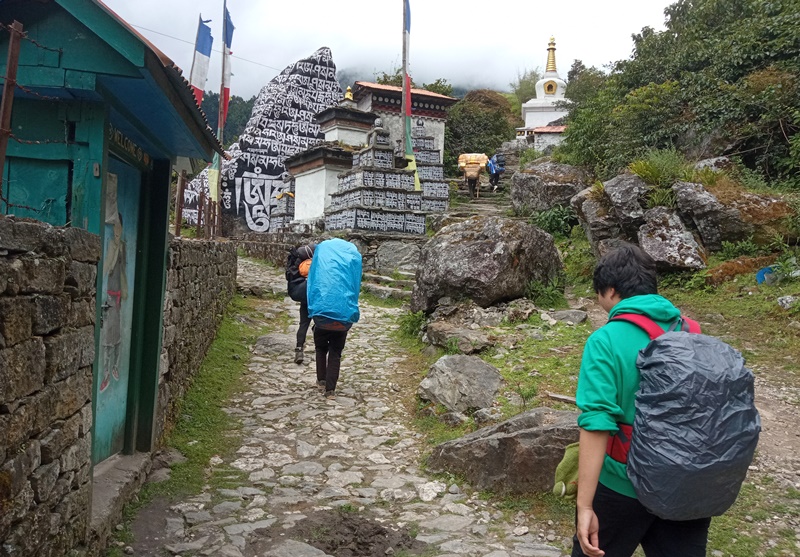
Decending from Namche to Lukla
The trekking route from Namche to Lukla is a breathtaking journey through the heart of the Khumbu region in Nepal. Starting in the vibrant town of Namche Bazaar at an elevation of 3,440 meters, trekkers embark on a scenic adventure. Namche is a bustling hub for trekkers and climbers and is the ideal place to acclimatize to the altitude. From Namche, the trail winds through rhododendron forests, offering stunning views of the snow-capped peaks of the Himalayas. One of the highlights along the way is the picturesque Tengboche at 3,860 meters, home to the famous Tengboche Monastery, which provides a spiritual and serene break in the journey. As the trail descends, you’ll cross the Dudh Koshi River and follow the winding path through charming villages, eventually reaching Lukla, the gateway to the Khumbu region. This town at an altitude of 2,800 meters marks the end of the trek and is where many trekkers and climbers begin their Himalayan adventures. The journey from Namche to Lukla is not only physically rewarding but also offers a rich cultural and natural experience amidst the towering peaks of the Everest region.
Day 12: Lukla to Kathmandu
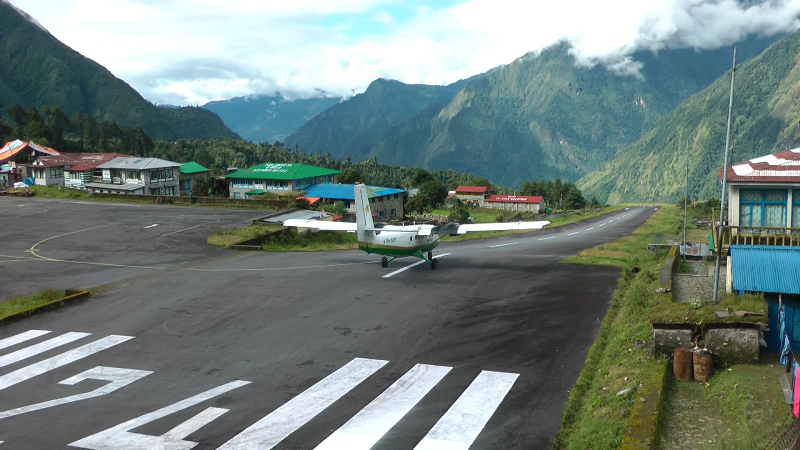
Lukla Airport
You’ll catch a flight from Lukla back to Kathmandu. This short flight provides one last opportunity to take in the stunning mountain views, weather permitting. Once back in Kathmandu, you can relax, celebrate your achievement, and explore the vibrant city.
The Everest Base Camp trek is an incredible journey through some of the world’s most beautiful and challenging terrain. The trekking hours can vary, but you should expect to walk 5-7 hours on average each day, with longer days on the way to Everest Base Camp and Kala Patthar.
Throughout the trek, it’s essential to be mindful of your health, stay hydrated, and listen to your body. Altitude sickness is a real concern, and it’s crucial to acclimatize properly and have an experienced guide with you to ensure a safe and enjoyable trekking experience. The altitudes mentioned for each location are approximate and can vary slightly depending on the specific route you take.